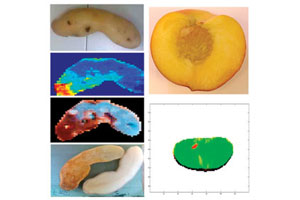Monitoring and sorting system wins silver medal

|
|
(Left): Potato has a sugar end, which is revealed by two NIR scans and the resultant brown area that shows up when cooked. (Right): The peach half has a pip splinter remaining, which is invisible to the naked eye, but revealed by a scan. Source: Insort. |
The food industry has employed analytical techniques in the lab using near-infrared (NIR) spectroscopy for some time. But putting this technology to use in an industrial production setting has not been practical. With recent advances in the continuous development of chemical imaging technology in the NIR, it’s now possible to acquire in-line process data of the chemical characteristics or food products in real time, i.e., with food products passing by a sensor on a conveyor belt.
Developed by EVK, hyper-spectral imaging systems simultaneously provide both spectral and spatial information of an illuminated surface (sample). These systems can be used for the efficient measurement of surfaces based on chemical and physical material properties.
The hyper-spectral imaging system delivers a complete spectrum with a resolution of 320 data points for each local pixel in the monitored area. It is this core technology that provides the basis for chemical imaging.
The sorting machine for potatoes (Sherlock Separator) makes use of the technology to find defects. Potato sugar ends, which cause blackened French fries, are the result of the accumulation of reducing sugars at the ends of potatoes. This common defect is invisible to the naked eye when a potato is raw; however, when the potato is fried, the defect becomes noticeable as an unsightly and unwanted browning of the ends of French fries (Maillard reactions). Because the potato industry produces partially fried (par-fried) French fries for distribution, the defect is invisible until the French fry is completely cooked at the customer location.
“With this technology, it is possible to detect and sort all the fundamental defects associated with potatoes, such as incomplete peeling, green potatoes and spoiled potatoes,” says Matthias Jeindl, Insort managing director. “Every kind of foreign object, and more specifically any defects that are normally invisible, can be detected and rejected.”
The technology can also be used to check fruits for foreign bodies. Obtaining an NIR spectrum of good quality produce can be used to compare a fruit that has a foreign object because the latter’s NIR spectrum will be dissimilar to that of the good fruit.
According to Jeindl, the potato sorter is being used at Frisch und Frost, an Austrian potato processor, which is now part of Lamb Weston. “F & F is producing French fries for McDonalds Austria,” he says.
The technology will become more widely available in the US—at least for potato applications—through a world-wide distributor in the potato industries, reports Jeindl. Since the equipment does require some customized setup, costs for the Sherlock Separator can range from $395,000 to $660,000 depending on capacity and required functions. Units designed for fruits, nuts and other foods may be somewhat lower in price.
For more information, visit www.insort.at/en/unternehmen.html.
Looking for a reprint of this article?
From high-res PDFs to custom plaques, order your copy today!






